Eons ago, when I was exploring long stitches I shared directions for a tuck stitch combination fabric 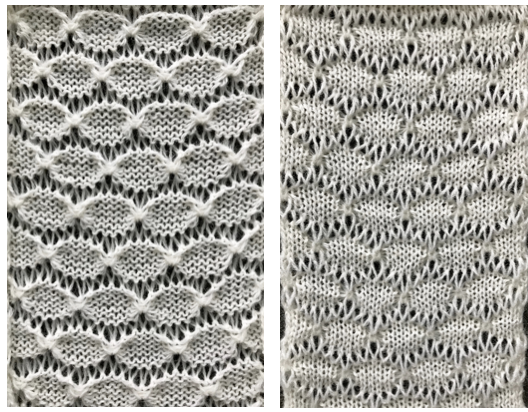 At about that time I came across this image on Pinterest.
At about that time I came across this image on Pinterest.
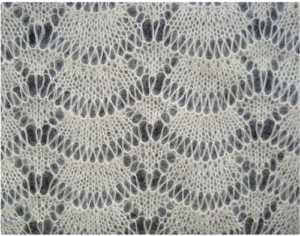 It combines transfer lace and long stitches, has characteristics that make some lace patterns unable to be reproduced on home knitting machines. Upon inspection, one will see that the number of stitches varies in different parts of the repeat. Aside from creating eyelets, the smaller triangular shapes increase in width, the fan shapes are decreased by half on their top row. Long stitches are created across all needles in work, then they are reconfigured so the center single stitch of the triangle and the center 2 stitches of the fan shape realign in the same position. The number of stitches at the start of the pattern and after the long stitches are created remains constant.
It combines transfer lace and long stitches, has characteristics that make some lace patterns unable to be reproduced on home knitting machines. Upon inspection, one will see that the number of stitches varies in different parts of the repeat. Aside from creating eyelets, the smaller triangular shapes increase in width, the fan shapes are decreased by half on their top row. Long stitches are created across all needles in work, then they are reconfigured so the center single stitch of the triangle and the center 2 stitches of the fan shape realign in the same position. The number of stitches at the start of the pattern and after the long stitches are created remains constant.  Trying variations on inspiration sources can lead to success, failure, somewhere in between, but also increase learning and skill that will carry over into other knitting techniques, even if the results are never used for a finished piece.
Trying variations on inspiration sources can lead to success, failure, somewhere in between, but also increase learning and skill that will carry over into other knitting techniques, even if the results are never used for a finished piece.
The Brother ribber is used to produce the long stitches. A bit of review: the bracket lever has 3 positions:
Dropping the ribber down 2 mm on each side gives enough clearance for thicker yarns. At a seminar, I saw Susanna use the position to create transfer lace in ribbed fabrics, something I have been threatening to try for decades, but have not yet. Here the lace carriage is shown in position, clearing the ribber’s gate pegs.  My preference is to create a chart in order to visualize and plan an “attack” prior to any knitting. White squares represent needles emptied by transferring their stitches to the right and to the left respectively. One must remember to keep empty needles in the work position to form eyelets.
My preference is to create a chart in order to visualize and plan an “attack” prior to any knitting. White squares represent needles emptied by transferring their stitches to the right and to the left respectively. One must remember to keep empty needles in the work position to form eyelets. 
 I found making the transfers easier an the process more visible if I dropped one side of the ribber to the second, 17 mm. position
I found making the transfers easier an the process more visible if I dropped one side of the ribber to the second, 17 mm. position
The ribber remains set to slip <– –> on all transfer rows, and any all knit rows on main bed only.  The ribber is set to N <– –> for three rows. On the first pass, all its needles will pick up the yarn, creating loops on every needle
The ribber is set to N <– –> for three rows. On the first pass, all its needles will pick up the yarn, creating loops on every needle
 With the ribber carriage alone, still set to N/N, free it, and make two passes to and from its starting side. The first pass releases the loops, the second returns it for coupling with the knit carriage. Below the long loops can be seen. My needle tape is “somewhere”, has not yet been returned to the ribber after my racking handle adventures were completed.
With the ribber carriage alone, still set to N/N, free it, and make two passes to and from its starting side. The first pass releases the loops, the second returns it for coupling with the knit carriage. Below the long loops can be seen. My needle tape is “somewhere”, has not yet been returned to the ribber after my racking handle adventures were completed. 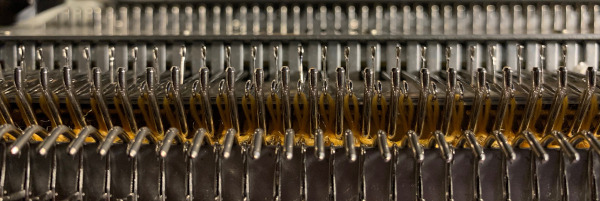 Return the ribber settings to slip in both directions, and repeat the process. Dropping the ribber to the lowest position at any point can verify goings-onHere one row has been knit on the main bed only, anchoring the loops, returning carriages to the opposite side prior to starting transfers once more
Return the ribber settings to slip in both directions, and repeat the process. Dropping the ribber to the lowest position at any point can verify goings-onHere one row has been knit on the main bed only, anchoring the loops, returning carriages to the opposite side prior to starting transfers once more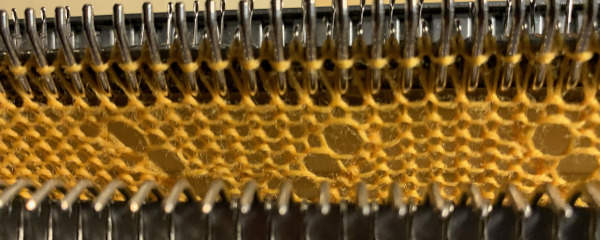 A word of caution: if loops are picked up on any single row that in theory was set to slip and was to be worked on only single bed, check to make certain the tuck lever has not been accidentally brought up to the tuck position. Although tuck <– –> can serve for a free pass on the main bed, having this setting on the ribber will create loops on all needles in work
A word of caution: if loops are picked up on any single row that in theory was set to slip and was to be worked on only single bed, check to make certain the tuck lever has not been accidentally brought up to the tuck position. Although tuck <– –> can serve for a free pass on the main bed, having this setting on the ribber will create loops on all needles in work  My test swatch had a couple of different# of transfer trials in horizontal segments and a few operator errors. It was knit in wool for the “spring” of the fiber, and unpressed formed pleats of sorts, while with a hard press it flattened out considerably, with not as much of a wave as I might like.
My test swatch had a couple of different# of transfer trials in horizontal segments and a few operator errors. It was knit in wool for the “spring” of the fiber, and unpressed formed pleats of sorts, while with a hard press it flattened out considerably, with not as much of a wave as I might like.
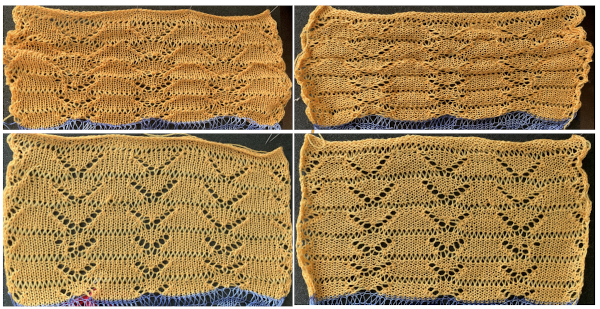 My later effort led to a fabric that was different from the inspiration one, but far more interesting to me than the one above. I began with a schematic, originally planning only 4 eyelets, then adjusted for 5 (yellow line marks the change)
My later effort led to a fabric that was different from the inspiration one, but far more interesting to me than the one above. I began with a schematic, originally planning only 4 eyelets, then adjusted for 5 (yellow line marks the change) 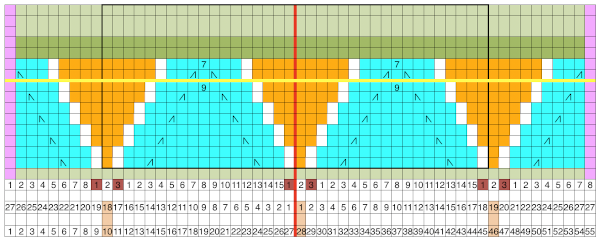 I cast on 55 stitches 27 left, 28 right. A ribber comb and weights are required.
I cast on 55 stitches 27 left, 28 right. A ribber comb and weights are required.
Having a chart with any numbering that makes sense to you is helpful.
I used a water-soluble pen to mark the center needle location for the start of transfers on either side, in this case, 18 left, 1 and 19 right. The 55 stitches include 2 full repeats of 18 plus a half (9) on each side edge.
Brother has 2 #1 positions, one on the left and the other on the right of center, separated above by the red line. The fact is something to be kept in mind with stitch counts for hand techniques where needle selection is not automated across the needle bed but is reliant on accurate counts by the knitter
A 3 prong tool was used to make transfers, the pattern could be translated for use with lace carriage if one desired to do so.
At the bottom of the swatch I stopped after 4 transfers before creating the long stitches, and then switched to 5 guessing I would like the transition better, also a clearer stopping place occurred when a single stitch was left with doubled-up ones on either side of it.
I did not find it necessary to drop the ribber at all to check on the progress of transfers. Below the swatch is shown on both sides, both relaxed (to my eye the more interesting) and after light pressing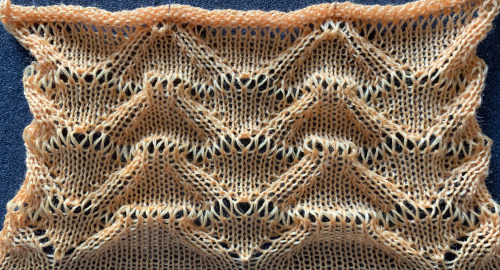
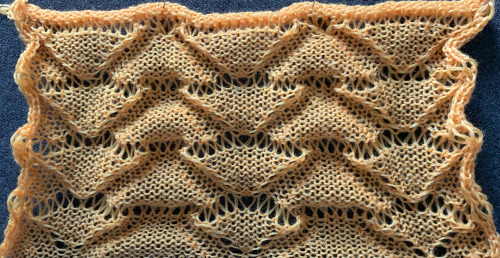
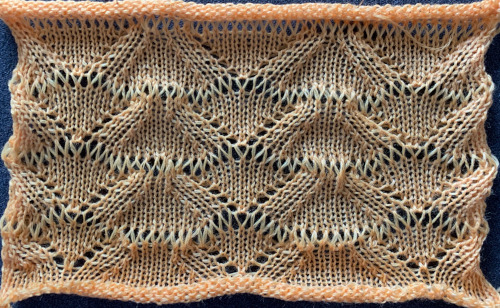
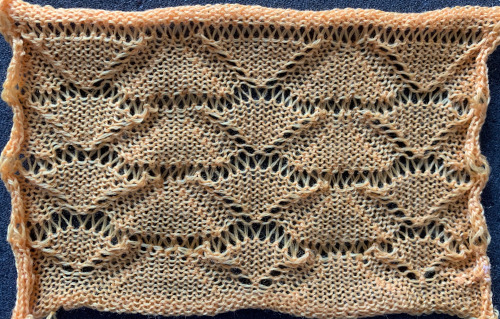
It appears to me to be the sort of fabric that is worth revisiting after a break. 😉